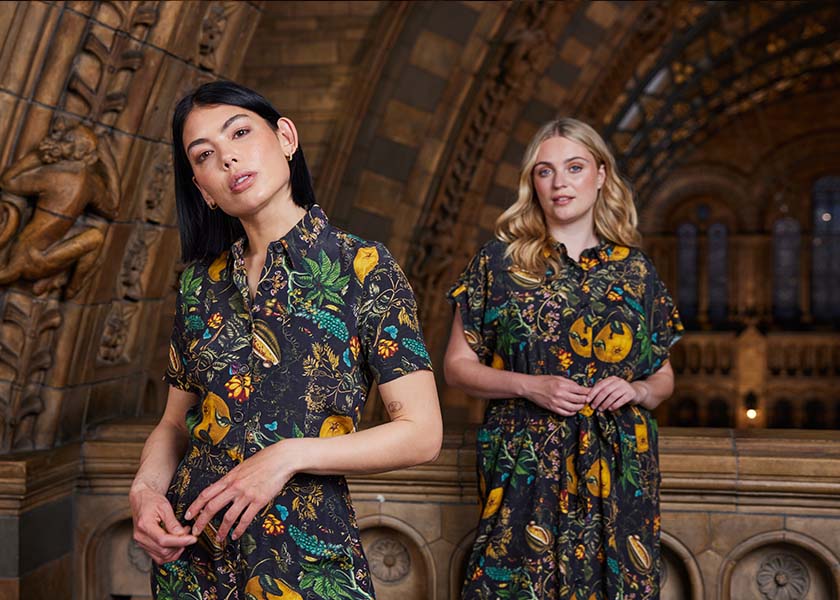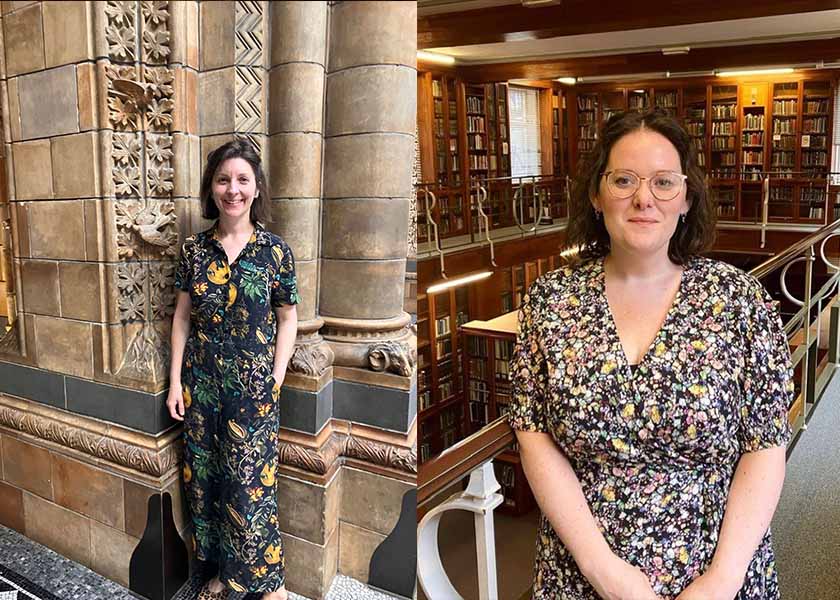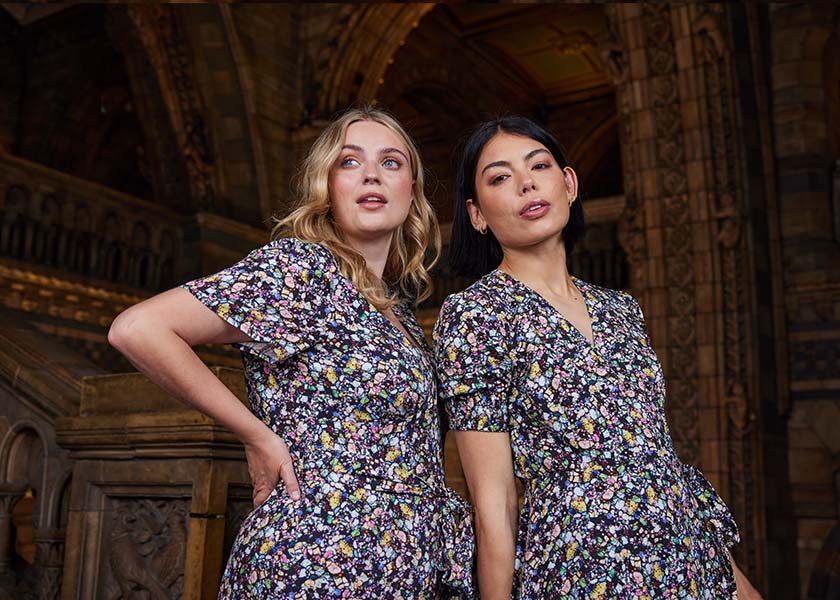To celebrate the second Natural History Museum X Joanie range, we're talking to some of the women who curate, research, and work with the Museum's incredible collections!
Emma and Kathryn work with the Natural History Museum's archives, helping manage some of the most exciting materials in the Museum. We sat down with them to learn more about their careers so far and what drew them to the Natural History Museum.
Hi guys! Can you tell us a bit about your jobs at the Museum and your specific areas of interest?
E: I am the Museum Archivist, which means I am responsible for managing the historic records of the Natural History Museum.
The Archive is a unique collection recording the history of the Museum and holds thousands of stories of people, collections, exhibitions, expeditions, and so much more. Together with Library Special and Library Modern Collections, NHM Library and Archives holds a fantastic collection of natural history literature, artwork, and information.
As well as looking after records like manuscripts and photographs which are a hundred or more years old, my role also increasingly includes looking after digital records (some of which are now already considered historic!) and making sure they will also be accessible to researchers for years to come.
K: I am the Assistant Archivist at the Museum, so my job is to help look after our Archive containing over 200 years' worth of letters, posters, guidebooks, artworks, photographs, and much, much more. The Archive is the institutional memory of the Museum and records how it has grown and changed over the past 142 years - why decisions were made, what has been exhibited, and expeditions Museum scientists have ventured on.
I help Readers, both colleagues and members of the public, to find what they need for their research, and I talk to people across the Museum about how to use this incredible resource.
What has your career looked like so far, and what drew you to working at the Natural History Museum?
E: I have worked at the Natural History Museum for three and a half years, and prior to NHM worked as an Archivist at various institutions, including another national museum, a university, and some local authority archives. I started out volunteering and then undertook traineeship and Archive Assistant roles before completing the professional postgraduate qualification in Archives and Records Management.
Since qualifying as an Archivist, I’ve always been drawn to museums, and who wouldn’t jump at the chance to work in such a beautiful place with such fascinating collections?! As someone with a historical rather than scientific background, it’s a constant opportunity for me to learn something new and be involved in such interesting projects and research.
K: I qualified as an Archivist in 2010 and have been lucky enough to work with lots of wonderful Archive collections since then - in universities, county record offices, historic houses, and businesses across England. I have been at the Natural History Museum for five years now, and this is my dream job! I never get bored of walking past Sophie Stegosaurus every day to get to my desk, and it’s fascinating to learn more about the world around us from the incredible scientists here.

What advice would you give to someone looking to follow in your footsteps and forge a career like yours?
E: If you’re interested in history, research and working with lots of different people, then Archives might be for you. Getting some work experience is the best way to understand what the job entails and whether you’ll enjoy it. Volunteering is a good place to start if that’s feasible, but there are also apprenticeships, traineeships, and entry-level assistant roles in the sector.
The great thing about being an Archivist is that is gives you the opportunity to work with lots of different organisations and types of collections, so whatever your interest, there is very likely something for you in the world of Archives.
K: I would advise anyone interested in becoming an Archivist to visit different Archives and chat to the Archivists there about what the job entails. People think it’s not a sociable job, but a lot of my role is people-facing - helping visitors with their research, invigilating the Reading Room, and talking to groups about how amazing the Archives are!
Try to get some voluntary work helping out in your local Record Office or Museum too, and get as much experience as you can before studying for a qualification in Archives and Records Management. You could also look at whether an apprenticeship scheme is available near you.
Out of everything you’ve encountered in the Museum’s archives, can you tell us about your favourite thing or the most interesting thing you’ve ever come across?
E: It is hard to choose a favourite, but the first thing that springs to mind is a series of photograph albums we hold, which include photographs taken by Museum visitors in the late nineteenth and early twentieth century. In the days before everyone had a camera or camera phone, those few visitors with cameras would take photographs of the galleries and send prints to the Museum.
The photographs were collected in three big albums, and they depict the Museums galleries and exhibits of that time as the visitors saw them. From records, the Museum appears to have employed its first Official Photographer in 1923, and as a result we continued to develop a wonderful photographic collection of the Museum over the years.
K: My favourite collection is the correspondence Archive of our sister museum in Tring. It contains hundreds of letters between Walter Rothschild’s curators and the explorers who travelled all around the world in the late 1800s/early 1900s collecting animals and bird specimens for him. They describe in great detail the places that they visit, the hardships of international travel in this period, and the wildlife and people they see.
These men endured months of travel, harsh climates and terrains, and even tropical diseases. In a letter written in 1907, one of my favourite letter writers, Lionel Walter Wiglesworth, even foretells the damage he sees being done to wildlife habitats and warns that there may be ‘nothing much left’ in 100 years.
What’s the most exciting thing about your job?
E: I love the collections and all the different stories they tell about the people, places, and the Museum of the past. The job is so varied, and there is always so much going on. In the Archives, we get to work with people from all over the Museum, from botanists and paleontologists to exhibitions and commercial collaboration colleagues; we get to contribute to so many different projects across the Museum using the records and the stories we look after, so its always interesting!
K: It’s exciting to be able to open a 150-year-old volume of letters and not know what you are going to read next. I feel very privileged to be able to read the words of men and women long dead and forgotten in their own hands, and to hear their voices, moods, and attitudes so clearly. There are characters in the Archive who I feel I know well and have become quite fond of, and some who I think I would have absolutely loathed! People don’t change much, whatever the century. There are funny ones, mean ones, and sad ones - an Archive is where their stories are kept alive.









